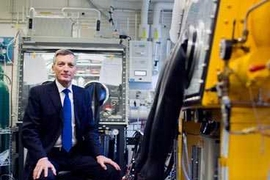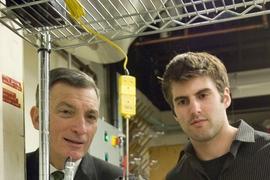The challenge of selling any new idea is that it has to compete with every other new idea. The process is more difficult when the idea’s technology hasn’t existed and addresses an issue that some industries don’t see as a problem. Such is the reality of Ambri.
The Cambridge, Mass., company started in an MIT laboratory with Professor Donald Sadoway and David Bradwell MNG '06 PhD '11. The former had a concept to overhaul energy storage; the latter needed a thesis project. The eventual result was a spinoff dedicated to creating a simply designed, low-cost, liquid metal battery. Now, after almost 10 years of research, Sadoway and Bradwell have a prototype to test. It’ll be a first step in answering the essential question of whether the device can work. If it does, it won't be a minor shift: “The technology can really revolutionize the way the entire electric grid infrastructure is operated,” Bradwell says.
The concept takes shape
Before there was Ambri, Donald Sadoway had an idea. The professor of materials chemistry wanted to find a way to stabilize conventional power and allow for the full-on adoption of renewable energy. Without a reliable source, wind and solar would remain endlessly talked-about without ever taking hold because of their intermittency, Sadoway says. The solution would be a battery, but it had to be different from the industry-standard lithium-ion. It would need to be stationary, long-lasting, and ready for commercial use.
It also, most importantly, needed to be affordable from inception — not an issue to be worked out in the manufacturing process. That fix-it-later approach doesn’t work with energy, since the competition isn’t from other batteries but from hydrocarbons. In order to take them on and force any industry to make a dramatic shift in power usage, something innovative needed to be done, Sadoway says.
Part of the inspiration to make the battery liquid came from Sadoway’s expertise in electrochemistry as applied to the production of metals — specifically, aluminum. He knew that aluminum smelting both consumes a massive amount of energy and is inexpensive. The question was, could the manufacturing process apply to a battery in which electricity can be both consumed and supplied on demand? Sadoway had two assets that proved helpful in taking on this problem: a concept and a master’s-degree student in need of a topic.
David Bradwell started working on the project in 2005. He made critical insights and corrections, Sadoway says, and ultimately co-invented an early model. Bradwell eventually earned his PhD, and the research advanced enough to require a dedicated off-campus office. Sadoway and Bradwell co-founded Ambri in 2010, and, to date, the company has raised more than $50 million in equity financing from the likes of Bill Gates, Total, Khosla Ventures, KLP Enterprises, and GVB.
Rolling out the chemistry
The specific materials have changed and the chemistry is confidential, Bradwell says, but the battery is composed of three layers of liquid: a light metal on top, a dense one on the bottom, and molten salt in the middle that acts as the electrolyte. The metals want to alloy with each other, thereby creating a current, and every time the battery is charged, the constituents are remade and purified with minimal degradation over time — about 0.0002 percent per cycle, Sadoway says.
Sadoway adds that he’s confident the electrochemistry is long-term-stable and will work with a variety of chemistries. What's more, the components are abundant and inexpensive. But Sadoway says that he’s also realistic. What Ambri has so far works on the single-cell level, but full battery systems are a plurality of cells that need to be balanced. Like an ice cube tray, each compartment essentially needs to be tilted so there’s an even charge coming from each cell.
A first-generation cell “balancing” system has already been developed at Ambri and demonstrated in the laboratory, and now the battery is ready for initial testing. In the next year, five prototypes will be sent to four locations around the United States, with each providing different practical feedback. On a Cape Cod military base, the battery will enable operations absent from the civilian grid — for example, during a power outage. In New York City, the battery will help relieve congestion in a region with high-power prices and a stressed grid. In Alaska and Hawaii, Ambri will test the battery’s ability to support renewable energy. As Bradwell says, Hawaii is dominated by expensive, imported diesel fuel. Rooftops are already overcrowded with wind and solar devices, so much so that much of the potential energy is being wasted and the existing system is being burdened.
Renewable energy is a particular target for Ambri’s work, but energy independence is an overall goal. The battery, and the storage it provides, makes operations more predictable and less vulnerable to fluctuations. Weather is an obvious uncertainty, but conventional plants are also inefficient, designed to handle maximum usage, even though that happens about 5 percent of the time, Sadoway says. The battery would mean stable operations and an ability to control costs. For any partner, “Having energy available on demand is at the core of their business,” Sadoway says.
However, Sadoway adds that without field data, any projections would be premature. And one of the challenges of selling this battery to conventional industries is that while they could benefit, they’ve never had to consider it, especially because it’s never been done before at an appreciable scale. It’s difficult to ask any industry to react to, let alone buy, a technology that doesn’t exist, Sadoway says.
The risk and the reward
Sadoway also knows that green technology would be an easier sell if it were still 2004. Regardless, with all the seeming risks and drawbacks, what the battery has is an MIT pedigree. The research, science, and approach come from the campus: “It’s an environment where nonsense will wither and excellence will flourish,” Sadoway says.
The office is located within walking distance of the Institute to take advantage of MIT colleagues, and Cambridge itself is a place where energy-related projects that involve years of work in a lab are taken on. “It’s really about building hardware to solve major issues in our world,” Bradwell says.
It’s that attitude that influences Ambri. Overhauling energy storage is a significant issue, one that requires big ideas and comes with unavoidable uncertainly. Bradwell and Sadoway accept that reality and realize their device might not appeal to every investor; it's simply another reality that comes with the zip code. “Low risk ideas mean incremental change, and the integral of many increments is not a radical departure,” Sadoway says. “People who are interested in incremental change and safe bets probably shouldn’t come to MIT. They’d be scared away.”








